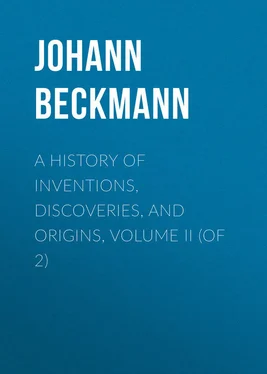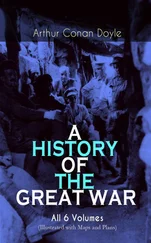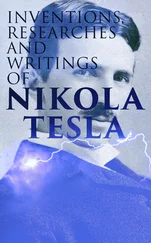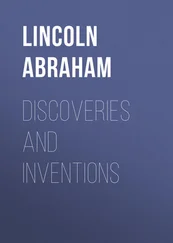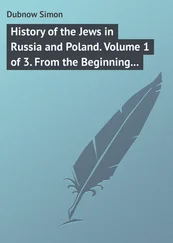Johann Beckmann - A History of Inventions, Discoveries, and Origins, Volume II (of 2)
Здесь есть возможность читать онлайн «Johann Beckmann - A History of Inventions, Discoveries, and Origins, Volume II (of 2)» — ознакомительный отрывок электронной книги совершенно бесплатно, а после прочтения отрывка купить полную версию. В некоторых случаях можно слушать аудио, скачать через торрент в формате fb2 и присутствует краткое содержание. Жанр: foreign_antique, foreign_prose, на английском языке. Описание произведения, (предисловие) а так же отзывы посетителей доступны на портале библиотеки ЛибКат.
- Название:A History of Inventions, Discoveries, and Origins, Volume II (of 2)
- Автор:
- Жанр:
- Год:неизвестен
- ISBN:нет данных
- Рейтинг книги:4 / 5. Голосов: 1
-
Избранное:Добавить в избранное
- Отзывы:
-
Ваша оценка:
- 80
- 1
- 2
- 3
- 4
- 5
A History of Inventions, Discoveries, and Origins, Volume II (of 2): краткое содержание, описание и аннотация
Предлагаем к чтению аннотацию, описание, краткое содержание или предисловие (зависит от того, что написал сам автор книги «A History of Inventions, Discoveries, and Origins, Volume II (of 2)»). Если вы не нашли необходимую информацию о книге — напишите в комментариях, мы постараемся отыскать её.
A History of Inventions, Discoveries, and Origins, Volume II (of 2) — читать онлайн ознакомительный отрывок
Ниже представлен текст книги, разбитый по страницам. Система сохранения места последней прочитанной страницы, позволяет с удобством читать онлайн бесплатно книгу «A History of Inventions, Discoveries, and Origins, Volume II (of 2)», без необходимости каждый раз заново искать на чём Вы остановились. Поставьте закладку, и сможете в любой момент перейти на страницу, на которой закончили чтение.
Интервал:
Закладка:
This astrological nomination of metals appears to have been conveyed to the Brahmans in India; for we are informed that a Brahman sent to Apollonius seven rings, distinguished by the names of the seven stars or planets, one of which he was to wear daily on his finger, according to the day of the week 68 68 Philostrat. Vita Apollonii, iii. 41, p. 130. How was the ring for Wednesday made? Perhaps it was hollow, and filled with quicksilver. Gesner, in Commentaria Societat. Scien. Gotting. 1753, iii. p. 78, thinks that these rings might have been made or cast under certain constellations.
. This can be no otherwise explained than by supposing that he was to wear the gold ring on Sunday; the silver one on Monday; the iron one on Tuesday, and so of the rest. Allusion to this nomination of the metals after the gods occurs here and there in the ancients. Didymus, in his Explanation of the Iliad, calls the planet Mars the iron star. Those who dream of having had anything to do with Mars are by Artemidorus threatened with a chirurgical operation, for this reason, he adds, because Mars signifies iron 69 69 Oneirocritica, v. 37.
. Heraclides says also in his allegories, that Mars was very properly considered as iron; and we are told by Pindar that gold is dedicated to the sun 70 70 Isthm. Od. ver. 1. Of the like kind are many passages in Eustathius on Homer’s Iliad, b. xi., and also the following passages of Constantinus Manasses, where he describes the creation of the stars, in his Annales (edit. Meursii, Lugd. 1616), p. 7, and p. 263: “Saturnus nigricabat, colore plumbeo; Jupiter ut argentum splendebat; Mars flammeus conspiciebatur; Sol instar auri puri lucebat; (Venus uti stannum;) Mercurius instar æris rubebat; Luna in morem glaciei pellucida suam et ipsa lucem emittebat,” &c.
.
Plato likewise, who studied in Egypt, seems to have admitted this nomination and meaning of the metals. We are at least assured so by Marsilius Ficinus 71 71 In his Preface to Critias. Platonis Opera; Francof. 1602, fol. p. 1097.
; but I have been able to find no proof of it, except where he says of the island Atlantis, that the exterior walls were covered with copper and the interior with tin, and that the walls of the citadel were of gold. It is not improbable that Plato adopted this Persian or Egyptian representation, as he assigned the planets to the demons; but perhaps it was first introduced into his system only by his disciples 72 72 It is probable that Ficinus had in view a passage in Olympiodori Commentar. in Meteora Arist. Ven. 1551, fol. lib. iii. p. 59.
. They seem, however, to have varied from the nomination used at present; as they dedicated to Venus copper, or brass, the principal component part of which is indeed copper; to Mercury tin; and to Jupiter electrum. The last-mentioned metal was a mixture of gold and silver; and on this account was probably considered to be a distinct metal, because in early periods mankind were unacquainted with the art of separating these noble metals 73 73 This distribution, which is ascribed to the Platonists, may be found also in the scholiasts on Pindar, at the beginning of the fifth Isthmian Ode, p. 459.
.
The characters by which the planets and metals are generally expressed when one does not choose to write their names, afford a striking example how readily the mind may be induced to suppose a connexion between things which in reality have no affinity or relation to each other. Antiquaries and astrologers, according to whose opinion the planets were first distinguished by these characters, consider them as the attributes of the deities of the same name. The circle in the earliest periods among the Egyptians was the symbol of divinity and perfection; and seems with great propriety to have been chosen by them as the character of the sun, especially as, when surrounded by small strokes projecting from its circumference, it may form some representation of the emission of rays. The semicircle is in like manner the image of the moon, the only one of the heavenly bodies that appears under that form to the naked eye. The character ♄ is supposed to represent the sythe of Saturn; ♃ the thunderbolts of Jupiter; ♂ the lance of Mars, together with his shield; ♀ the looking-glass of Venus; and ☿ the caduceus or wand of Mercury.
The expression by characters adopted among the older chemists agrees with this mythological signification only in the character assigned to gold. Gold, according to the chemists, was the most perfect of metals, to which all others seemed to be inferior in different degrees. Silver approached nearest to it; but was distinguished only by a semicircle, which, for the more perspicuity, was drawn double, and thence had a greater resemblance to the most remarkable appearance of the moon; the name of which this metal had already obtained. All the other metals, as they seemed to have a greater or less affinity to gold or silver, were distinguished by marks composed of the characters assigned to these precious metals. In the character ☿ the adepts discover gold with a silver colour. The cross placed at the bottom, which among the Egyptian hieroglyphics had a mysterious signification 74 74 Jablonski, Pantheon Ægypt. i. p. 282, 283, 287; and ii. p. 131. This author makes it the representation of something which cannot be well named. Kircheri Œdipus Ægypt. t. ii. pars ii. p. 399. Romæ, 1653, fol.
, expresses, in their opinion, something I know not what, without which quicksilver would be silver or gold. This something is combined also with copper, the possible change of which into gold is expressed by the character ♀. The character ♂ declares the like honourable affinity also; though the half-cross is applied in a more concealed manner; for, according to the most proper mode of writing, the point is wanting at the top, or the upright line ought only to touch the horizontal, and not to intersect it. Philosophical gold is concealed in steel; and on this account it produces such valuable medicines. Of tin one-half is silver, and the other consists of the something unknown: for this reason the cross with the half moon appears in ♃. In lead this something is predominant, and a similitude is observed in it to silver. Hence in its character ♄ the cross stands at the top, and the silver character is only suspended on the right-hand behind it.
The mythological signification of these characters cannot be older than the Grecian mythology; but the chemical may be traced to a much earlier period. Some, who consider them as remains of the Egyptian hieroglyphics 75 75 Goguet, ii. pp. 370, 371, considers them as remains of the original hieroglyphics; but he is of opinion that we received them in their present form from the Arabians.
, pretend that they may be discovered on the table of Isis, and employ them as a proof of the high antiquity, if not of the art of making gold, at least of chemistry. We are told also that they correspond with many other characters which the adepts have left us as emblems of their wisdom.
If we are desirous of deciding without prejudice respecting both these explanations, it will be found necessary to make ourselves acquainted with the oldest form of the characters, which in all probability, like those used in writing, were subjected to many changes before they acquired that form which they have at present. I can, however, mention only three learned men, Salmasius 76 76 Plinianæ Exercitat. in Solinum, p. 874.
, Du Cange 77 77 Gloss. ad Script. Med. et Infimæ Græcitatis.
, and Huet 78 78 In his Annotations on Manilii Astronomicon (in usum Delphini). Par. 1679, 4to, p. 80.
, who took the trouble to collect these characters. As I am afraid that my readers might be disgusted were I here to insert them, I shall give a short abstract of the conclusion which they form from them; but I must first observe that the oldest manuscripts differ very much in their representation of these characters, either because they were not fully established at the periods when they were written, or because many supposed adepts endeavoured to render their information more enigmatical by wilfully confounding the characters; and it is probable also that many mistakes may have been committed by transcribers.
Интервал:
Закладка:
Похожие книги на «A History of Inventions, Discoveries, and Origins, Volume II (of 2)»
Представляем Вашему вниманию похожие книги на «A History of Inventions, Discoveries, and Origins, Volume II (of 2)» списком для выбора. Мы отобрали схожую по названию и смыслу литературу в надежде предоставить читателям больше вариантов отыскать новые, интересные, ещё непрочитанные произведения.
Обсуждение, отзывы о книге «A History of Inventions, Discoveries, and Origins, Volume II (of 2)» и просто собственные мнения читателей. Оставьте ваши комментарии, напишите, что Вы думаете о произведении, его смысле или главных героях. Укажите что конкретно понравилось, а что нет, и почему Вы так считаете.
